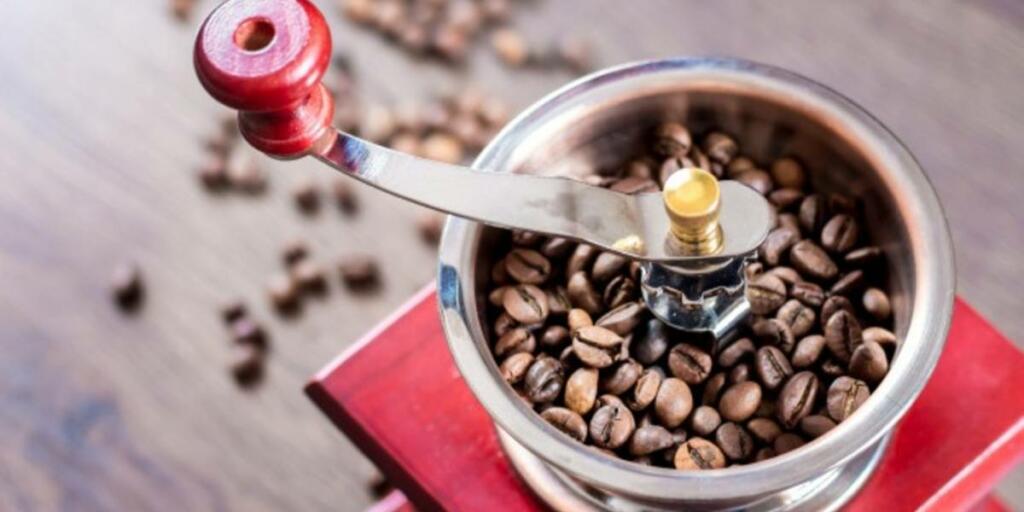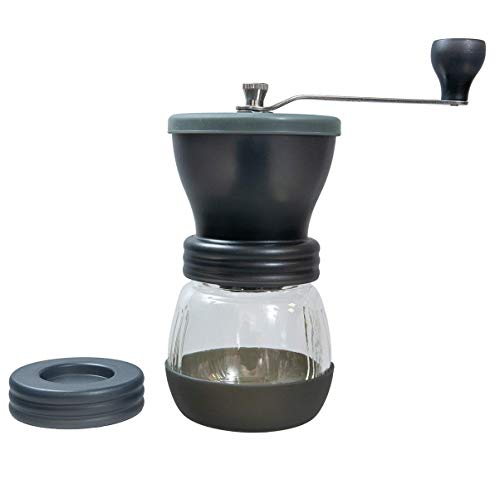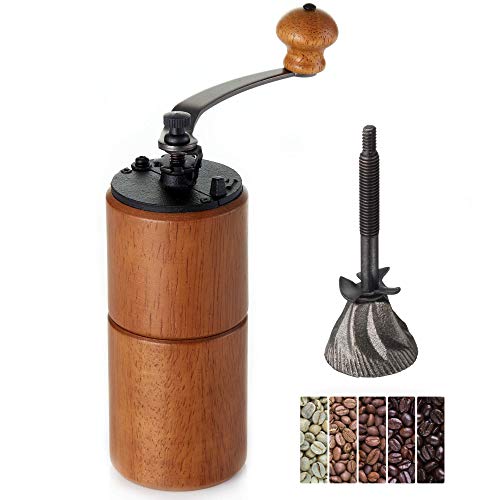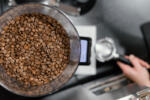Any coffee connoisseurs know there’s nothing like grinding your beans before your brew. This is the most optimal means to maximize the aroma and flavor of your coffee. What if you’re always on the go and still want this luxury? Well, you won’t have to carry your big electric grinders around! Best manual coffee grinders are here to save your days.
Table Of Contents
−- Best manual coffee grinders
- Importance of using a coffee grinder
- Buyer’s guide
- Why should you get a manual grinder?
- FAQs
Best manual coffee grinders
1. 1Zpresso Q2 Manual Coffee Grinder
- Premium materials
- Hopper capacity: 20g (1-2 coffees/grind)
- Weight: 385g
- Dimensions: 5.5” x 2” x 2”
- Burr: Stainless steel
This, without a doubt, is our overall top pick. It is the smallest in its line and cheaper than others too. But, you’d be surprised how its quality was not sacrificed! It truly is small but terrible.

This is great for small batches of coffee, especially for camping trips or your office use. However, the downside is its small 20g capacity, which is only enough for one brew. But, with its build, ease of use, and great price tag, this is the one to beat!
Pros
- Premium build
- Portable
- Lightweight
- Easy to grind
- Value for money
Cons
- Limited capacity
2. Zassenhaus Santiago Coffee Mill Grinder
- Vintage
- Works great for Turkish coffee
- Hopper capacity: 40g (2-3 coffees/grind)
- Dimensions: 5.5” x 3.5” x 7.8”
- Burr material: High-grade carbon steel conical burr
This grinder from Zassenhaus is a vintage one that’s especially great for brewing Turkish coffee. Plus, it has an incredible 25-year warranty so that you can ensure its high-quality build. It comes in various color options, such as black and beechwood.
Although it may be a little bigger than other hand grinders, it is still smaller than regular electric grinders. It’s known to produce consistent grinds with many grind settings to select from. This is why it can grind the Turkish way! This unit is also perfect if you want to brew some delicious espresso.
Pros
- High-quality materials
- Conical burrs keep the integrity of the beans
- 25-year no-break warranty
Cons
- Quite heavy
- Pricey
- The grind setting dial has no numbers, so you must keep estimating.
3. Porlex Mini Stainless Steel Grinder
- Great for travels
- Minimalist design
- Hopper capacity: 20g (1-2 coffees/grind)
- Weight: 226 g
- Dimensions: 6” x 2.3” x 1.8”
- Burr material: Ceramic conical burr
- Grind settings: 13
The Porlex Portable Coffee Mill is our best bet for travelers out there. It comes in a portable and easy-to-grip cylindrical shape. You can carry this one easily during your hikes, bike sessions, or even in your car for road trips. It is lightweight at 10.4 ounces and fits wonderfully into the Aeropress.
It has a stainless steel build; thus, it is durable and easy to clean. With its little dial, you can easily grind fine, coats, or somewhere in between accurately. Overall, it has 13 settings which are easily identified via the ‘click’ sound.
Pros
- Easy to use
- Versatile
- Portable
Cons
- It May be too simple for some
- Small capacity
4. Hario Skerton Pro Ceramic Coffee Mill
- Multiple brews at once
- Hopper capacity: 100g (4+ coffees/grind)
- Weight: 566g
- Dimensions: 16” x 11” x 13”
- Burr material: Ceramic conical burr
If you normally grind around 4 cups at a time, this one will be your best friend. The ergonomically-designed Hario Skerton Pro is lightweight but has a large capacity. In addition, it has a slip-free rubber base to keep accidents at bay. It is also known for its grind precision.
This is extremely easy to assemble. Its hopper sits well in any mason jars or containers. It’s easy to use and easy to clean. With this, you’ll have a flavorful cup of coffee in no time!
Pros
- Slip-free rubber base
- Easy to assemble
- Easy to clean
- Large capacity
Cons
- Requires elbow grease to grind
- Fragile
- Not the most lightweight
5. Akirakoki Manual Coffee Bean Grinder
- Crack-resistant solid wood design
- Hopper capacity: 85g (3-4 coffees/grind)
- Weight: 610g
- Dimensions: 7.2” x 2.8” x 2.8”
- Burr: Cast iron
This design won our hearts. This Akirakoki does the job pretty well without breaking the bank. It is made of a single piece of wood. Thus, it won’t crack! Plus, the cast iron burr never rusts too!
This might be the one for you if you’re all for aesthetics without sacrificing functionality. Plus, it has a decent capacity compared to other manual grinders.
Pros
- Aesthetically pleasing
- Cast iron burr reduces heat
- Budget-friendly
Con
- Time-consuming grinding
6. Timemore Chestnut G1
- Attractive design
- Great for beginners or pros
- Hopper capacity: 30g
- Weight: 568.5 g
- Dimensions: 6.7” x 2.0” x 2.0”
- Burr: Stainless steel
This is so greatly designed that it will capture everyone’s heart. The Chestnut G1 grinder is made of metal and a wood saw. It looks great that it won the Red Dot Design Award in 2017. Amazing.
Most of its body is made of lightweight aluminum alloy that’s great for camping trips and travels. Moreover, the crank arm, burrs, and driveshaft are stainless steel, with good durability. It’s also easy and comfortable to handle, which is an important feature for all manual grinders.
This model is tested to produce a uniform grind for even extraction. It does so with its two ball bearings for a more stable grinding mechanism. With this, you are promised an easy grinding experience with its 38 mm conical steel burrs. In addition, it offers different grinds that work wonderfully, from Turkish to French Press coffee!
Pros
- Stepped adjustment
- Aesthetically pleasing
- Lightweight
Con
- Not for specialty coffee
7. Comandante C40
- Durable and professional-grade grinder
- Hopper capacity: 40-45g
- Weight: 1.63 lbs
- Dimensions: 6.3” x 2.4” x 2.4”
- Burr: Patented high-alloyed and high-nitrogen stainless steel
If you want some next-level manual brewing, the Comandante C40 may work for you. It may be small, but it houses a professional-level burr set. Its high-nitrogen alloy conical burrs make the sharpness and durability truly evident, creating fluffy and uniform grounds. All the rest of the components are made of stainless steel. Take note that for travel purposes, you may think twice about opting for this because it’s quite heavy.
With the stepped grind adjustment feature, you can easily monitor your favorite grind settings. Plus, you have a great range of grind settings to choose from! This unit is wrapped in a beautiful wood veneer in a cylindrical body. There are six different finishes to choose from, so we’re sure you’ll find one that will be attractively on your countertop.
Pros
- Professional-grade grinder
- Great grind setting options
- Durable
Con
- Quite heavy
8. JavaPresse Manual Coffee Grinder
- Hopper capacity: 40g (2-3 coffees/grind)
- Weight: 266g
- Dimensions: 1.8” x 7.5” x 1.8”
- Burr material: Ceramic conical burr
- Grind settings: 18
The JavaPresse Manual Coffee Grinder wins our best value for money. It is a small and lightweight grinder without sacrificing functionality. Consider this if you need a grinder you can carry around, especially because of the detachable hand crank. In addition, it has a stainless steel body and a ceramic conical burr to give you a great grinding experience.
It also uses a click system to adjust grind settings. There’s a learning curve before you master using this feature, but it should not take long. This is budget-friendly while still doing the job wonderfully.
Pros
- Affordable
- Compact and portable
- Lightweight
Cons
- Lower quality materials
- Tricky grind settings
- May be harder to grind with compared to others
Importance of using a coffee grinder
A coffee grinder is important because it keeps your coffee as fresh as possible. Pre-ground coffee has a lot less aroma than freshly ground one. On the other hand, whole beans will lock all the flavors in, especially if consumed between 5-7 days and 4 weeks post-roast.
For best results, grind size should be even. This goes true for the shape and will promote even extraction. Thus, this is one feature you should look out for in a grinder.
Buyer’s guide
Here are the things you should consider before deciding on your grinder purchase:
Size
If you’re in the comfort of your home most of the time, consider investing in a larger electric grinder. However, if you’re always on the go, you should get a more portable one that’s cylindrical for easy gripping and usage.
Capacity
Know how many cups you or your group need in a day so you’d know what capacity your grinder should have. If you only need a grinder for you, that may be great! But if you need to grind for 2-3 people, just think how much a manual grinder will work those arms out.
Quality of burr
You’d almost always have to choose between two burr options: ceramic or stainless steel. Stainless steel is durable and easy to clean, making it great for travel. On the other hand, ceramic burrs are less durable but should be fine if you have to keep them still at home. Your burr will determine your grind quality, so consider this well.
Grind settings
Different coffee types require different grinds. For versatility, you do not want a grinder that just grinds with no other settings. You need to have something that grinds to different tastes. A great and functional grinder should always be precise and consistent to avoid an over-or under-extracted cup of Joe. To even up your game, you use a coffee sifter to create consistent results for better extraction.
Bean uniformity
One great thing about hand grinders is that they use burrs rather than blades. This means the beans will be shaved instead of cracked, increasing the grind uniformity.
Longevity
While electric grinders typically come with warranties, most manual grinders don’t. So if you can, find one that has! Any manufacturer that gives some warranty reflects their confidence in their product’s longevity. Take note that you have to regularly clean your grinder to increase the longevity of your burr!
Espresso or filter
Decide what you need and choose from there!
Price point
Of course, you have to set a budget and work around that. However, keep in mind that you get what you pay for! So typically, the pricier it gets the more ease of use and settings you’ll have. But always for reviews!
Ceramic or steel burrs?
Hand grinders house conical burrs, and they’re typically either steel or ceramic. Steel is sharper. Thus, it does the job better. It’s also faster and more consistent than ceramic, but it may come at a higher price.
Length of the handle
As a general rule: the shorter the handle’s length, the more energy, and effort you have to grind the same amount of beans. Thus, you’d want a longer one!
Why should you get a manual grinder?
Affordability
Manual grinders are cheaper than electric grinders for obvious reasons. But the great thing about a manual grinder is that it houses what an electric grinder uses to grind, and this is the burr. So you shouldn’t be sacrificing the grind quality while also saving money!
Durable hand crank mill
Nothing like waking up in dire need of your coffee only to find out your electric grinder is not working. What’s even worse? More often than not, you’ll need a repair guy to help you too! This happens much less with manual grinders as they do not rely on complicated mechanisms to grind your beans.
Travel-friendly
A hand grinder is compact, so you can carry it around, especially if you handpick a good model. On top of our list of travel-friendly options are the Porlex Mini and the 1Zpresso Mini Q!
No heat while grinding
Because of the high revolutions per minute electric grinder systems generate, it also generates heat due to excessive friction. This is counterproductive because it dissolves some of the aromas in your beans! On the other hand, manual grinders do not produce heat, so that’s not a problem here.
Delicious coffee
When it comes to the taste of the coffee, a manual grinder can deliver just that the same way electric grinders can.
FAQs
How long does a manual coffee grinder take to grind?
To grind for a big cup typically takes around a minute of effort. But, flagship models such as 1Zpresso Jx can grind faster. For example, it can grind for 2-3 cups in less than 45 seconds. Alternatively, cheaper ceramic burrs grind 3 scoops for 2-3 minutes.
Tip: If you constantly need a fine grind, you must turn the crank more frequently. For this reason, we suggest opting for an electric grinder for fine grinds such as espressos.
Which is better: manual or electric grinders?
This depends! Manual coffee grinders are cheaper, simple, and portable. Meanwhile, electric grinders require a lot less effort from you and may grind faster. But, again, it depends on your preference!
To grind or not to grind?
Here’s a quick answer: it’s definitely TO GRIND! As we’ve discussed, grinding your coffee keeps all the flavors and aromas. This way, you will have nothing shorter than a fresh cup of Joe than if you use some pre-ground coffee.
Disclaimer: This post contains affiliate links, which means I may receive a small commission, at no extra cost to you, if you make a purchase using these links. Remember to support us by purchasing through the Amazon/Walmart/Impact Radius links provided. Last update on 2024-04-19 / Affiliate links / Images from Amazon Product Advertising API
Disclosure: No compensation or free products were received in exchange for writing this review.

Editorial Staff
The editorial staff at Crazy Coffee Crave is a team of coffee enthusiasts & Baristas who enjoy the one thing we all think about as soon as we get up in the morning. Trusted by thousands of readers worldwide.












